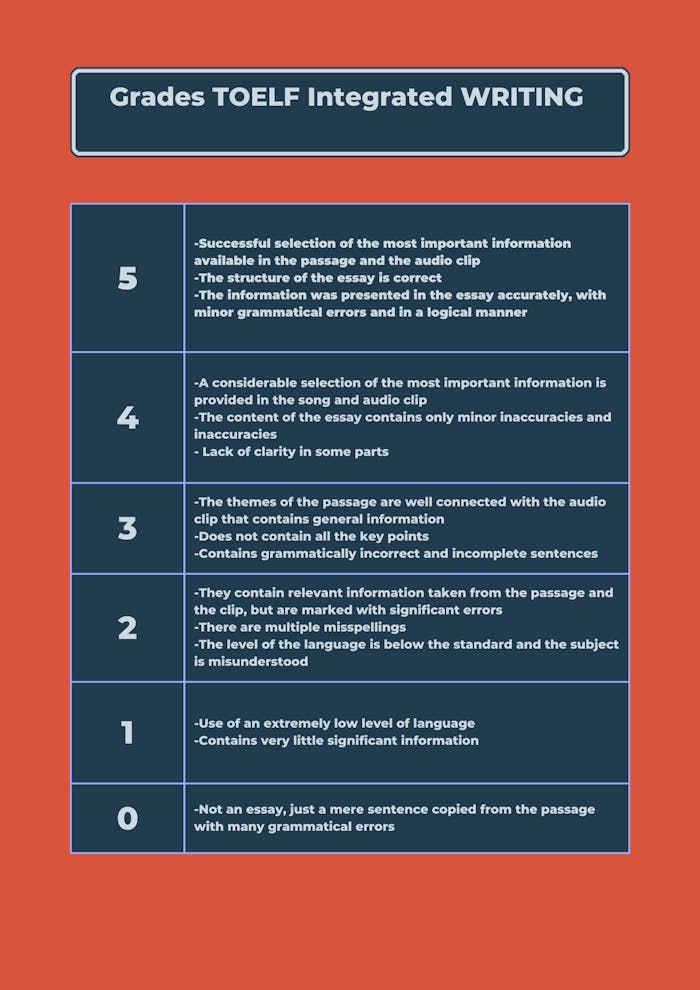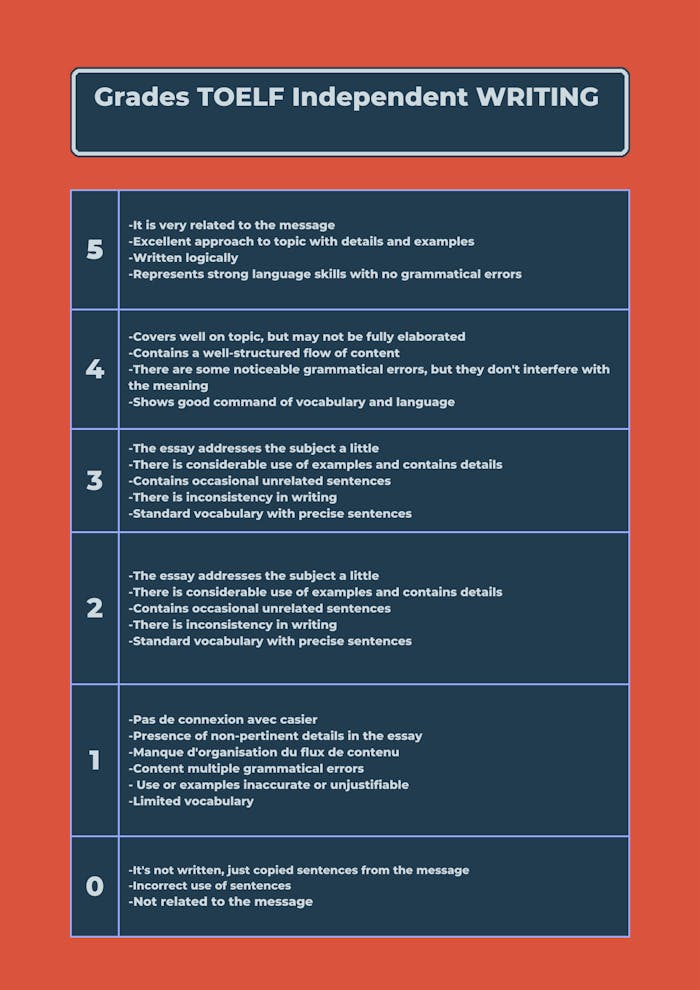TOEFL Writing: What is a good score?, difficulty, practical examples and topics.
Writing is one of the fundamental pieces when it comes to learning English, because it allows us to organize our listening and speaking skills in a structure that prepares us to use it on a day-to-day basis.
The Writing section of the TOEFL iBT measures your ability to write in English in an academic environment, and that you are able to present your ideas and concepts in a clean and organized way.
At Speakingathome we can help you manage this part of the TOEFL exam
TOEFL Writing: How is the evaluation carried out?
The TOEFL Writing test is divided into 2 parts: an Integrated Writing part that lasts 20 minutes in which you read a short passage and listen to a short audio, then write and respond to what was read. In this part you are allowed to take notes of what you read.
The other section of the exam lasts half an hour and consists of the production of an independent writing (Independent Writing), which must be an essay based on personal experience or opinion in response to a particular topic. These 2 parts together will not last more than 50 minutes.
TOEFL Writing: What is the scoring system like?
The TOEFL Writing scoring system uses a 1-30 measurement system. 24-30 is advanced, 17-23 is upper intermediate, 13-16 is lower intermediate, 7-12 is basic, and 0-6 is below basic. However, this part of the exam, being divided into 2 parts, is used in 2 ways when it comes to categorizing the answers.


TOEFL Writing: Difficulty
As mentioned above, the difficulty in the Writing section of the TOEFL test will depend on how the written academic text is organized. The coherence, the variety of vocabulary, and the connection of the ideas that together make up an essay with a good common thread and clear answers.
However, this is not binary, as much as in Speaking and Writing, there are degrees that determine how correct one can be.
TOEFL Writing: Example
Writing Practice Set 1 (Integrated): Passage, Lecture, and Question Directions: Give yourself 3 minutes to read the passage.
Reading Time: 3 minutes
In an effort to encourage ecologically sustainable forestry practices, an international organization started issuing certifications to wood companies that meet high ecological standards by conserving resources and recycling materials. Companies that receive this certification can attract customers by advertising their products as “ecocertified.” Around the world, many wood companies have adopted new, ecologically friendly practices in order to receive ecocertification. However, it is unlikely that wood companies in the United States will do the same, for several reasons.
First, American consumers are exposed to so much advertising that they would not value or even pay attention to the ecocertification label. Because so many mediocre products are labeled “new” or “improved,” American consumers do not place much trust in advertising claims in general.
Second, ecocertified wood will be more expensive than uncertified wood because in order to earn ecocertification, a wood company must pay to have its business examined by a certification agency. This additional cost gets passed on to consumers. American consumers tend to be strongly motivated by price, and therefore they are likely to choose cheaper uncertified wood products. Accordingly, American wood companies will prefer to keep their prices low rather than obtain ecocertification.
Third, although some people claim that it always makes good business sense for American companies to keep up with the developments in the rest of the world, this argument is not convincing. Pursuing certification would make sense for American wood companies only if they marketed most of their products abroad. But that is not the case—American wood businesses sell most of their products in the United States, catering to a very large customer base that is satisfied with the merchandise
Directions: Read the transcript
Narrator: Now listen to part of a lecture on the topic you just read about.
Professor: Well, despite what many people say, there’s good reason to think that many American wood companies will eventually seek ecocertification for their wood products. First off, consumers in the United States don’t treat all advertising the same. They distinguish between advertising claims that companies make about their own products and claims made by independent certification agencies. Americans have a lot of confidence in independent consumer agencies. Thus, ecologically minded Americans are likely to react very favorably to wood products ecologically certified by an independent organization with an international reputation for trustworthiness.
Second point—of course it’s true that American consumers care a lot about price—who doesn’t? But studies of how consumers make decisions show that price alone determines consumers’ decisions only when the price of one competing product is much higher or lower than another. When the price difference between two products is small—say, less than five percent, as is the case with certified wood— Americans often do choose on factors other than price. And Americans are becoming increasingly convinced of the value of preserving and protecting the environment.
And third, U.S. wood companies should definitely pay attention to what’s going on in the wood business internationally, not because of foreign consumers, but because of foreign competition. As I just told you, there’s a good chance that many American consumers will be interested in ecocertified products. And guess what, if American companies are slow capturing those customers, you can be sure that foreign companies will soon start crowding into the American market, offering ecocertified wood that domestic companies don’t.
Directions: Give yourself 20 minutes to plan and write your response. Your response is judged on the quality of the writing and on how well it presents the points in the lecture and their relationship to the reading passage. Typically, an effective response will be 150 to 225 words. You may view the reading passage while you respond.
Response time: 20 minutes
Question: Summarize the points made in the lecture, being sure to explain how they cast doubt on specific points made in the reading passage.
Writing Practice Set 2 (Independent): Question
Directions: Read the question below. Give yourself 30 minutes to plan, write, and revise your essay. Typically, an effective response will contain a minimum of 300 words. Reading Time: 30 minutes
Question: Do you agree or disagree with the following statement? Television advertising directed toward young children (aged two to five) should not be allowed.
Use specific reasons and examples to support your answer
TOEFL Writing: Frequent Topics and Subjects
Most of the topics used for the TOEFL exams are current affairs related to the economy, society, politics, technology and everyday things; as recycling or urban.
Likewise, it is for this reason to always be informed regarding the general culture in order to create varied answers when the TOEFL exam must be given and in this way a rich writing can be done.
